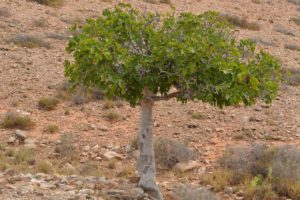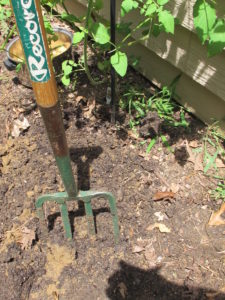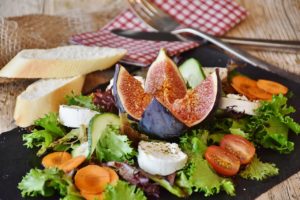Page 2
How To Plant and Grow Fig Trees
Hardiness
Life is simpler if you plant varieties that are comfortably hardy in your area. With warmer temperatures slowly creeping north, cultivars that previously would have perished are now thriving, especially in urban microclimates. Check several sources, including your local agricultural extension office, for recommendations.
If the variety of choice will be a challenge in your zone, plant it on the south or east side of the house, out of the winter wind. But don’t plant it so close that the warmth encourages early bud break. Mulching helps prevent the soil from freezing deeply. Varieties available with a bit of searching are listed at the end of this article.
Where winter temperatures drop suddenly or below their comfort zone, fig trees might die off above ground. They often sprout new growth from the crown of the plant, but be patient. This happened to my ‘Violette de Bordeaux’. All the existing stems died, but it did grow new stems. No fruits yet. This year, I’ll construct a screen around the plant to protect it from extreme low temperatures. And the next fig tree I’ll plant will be hardier (‘Celeste’, probably).
Fig trees grow fast, about 3′ to 5′ per year, with adequate nutrition.
Sun
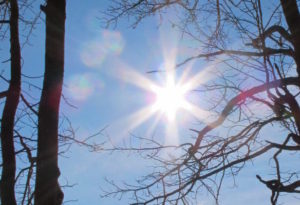 Choose a site that receives at least 8 hours of direct sunlight. Allow ample room for the tree to spread its branches. Fig trees ordinarily are broader than they are tall. So, don’t make the mistake of planting the cute little tree 5′ from the house. Not far enough!
Choose a site that receives at least 8 hours of direct sunlight. Allow ample room for the tree to spread its branches. Fig trees ordinarily are broader than they are tall. So, don’t make the mistake of planting the cute little tree 5′ from the house. Not far enough!
Because the fig tree can live more than 100 years, locate trees carefully. A 6′ scarlet oak planted 20′ away could begin casting shade on the fig in less than 10 years, when the fig is bearing abundantly. Shade will diminish the crop. So, plant other trees way to the north (northern hemisphere) of or sufficiently distant from the fig.
Soil Preparation For Fig Trees
Off To a Good Start
A common theme throughout this blog is the emphasis on soil preparation. The plants will thank you! I like to improve the soil over a wide area, at least three times the width of the container. In heavy clay soils, I might loosen the soil in a wider area.
But, over time, natural mellowing of the soil takes place as mulch decomposes and as you add compost as a top dressing. Loosen the soil a few inches deeper than the height of the pot. Planting the root ball slightly above the surrounding soil level ensures that oxygen will reach the top layer of roots.
Wait a day or two before digging if you’ve just had a heavy rainstorm. Digging in wet soil can harm the soil structure by squeezing out air spaces between the particles.
Dig In!
One of my favorite tools for new beds and compacted soil is a heavy garden fork. This fork is more effective than a shovel for loosening the top 16″ to 20″ of soil.
If a soil test indicates the need for lime, add that now. Figs like soil that is slightly acidic, with pH around 6.5-7.0.
In heavy clay soil that drains poorly, add about 5″ of pine fines to the loosened soil. Coarse sand (not play sand) or horticultural grit can substitute for some of the pine fines. Pine fines are small pieces of partially decomposed pine bark, and not the same as pine bark mulch. It decomposes very slowly, especially at lower soil levels where there’s less oxygen and less microbial activity.
Incorporate the amendments into the full depth of loosened soil. Don’t layer materials in the soil, and don’t place gravel in the bottom of the hole. Large air pore spaces between the pieces of gravel attract water and rot roots that stay wet if the water can’t quickly drain away.
A few annual applications of gypsum (calcium sulfate) help with drainage issues. Gypsum flocculates tiny clay particles into larger particles, adding small channels for water and air to drain through.
Nutrients For Now
Now that drainage has been addressed, lay down 3″ or 4″ of compost or planting mix, for their nutrients and tilth, over an area twice the diameter of the pot. Incorporate that material into the top 8″ of the soil. Sandy soils need more compost and clean loam to hold water near the roots.
Now the soil is well prepared for the fig tree. If you’re fortunate and have a thick layer of naturally good topsoil, you won’t have to add as much new material.
Time To Plant
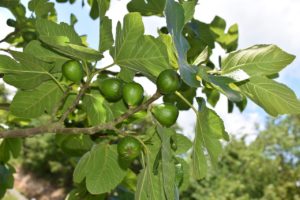 Water the tree to help it slide out of the pot. Tilt the tree and, letting gravity help you, coax it out instead of pulling the trunk of the tree.
Water the tree to help it slide out of the pot. Tilt the tree and, letting gravity help you, coax it out instead of pulling the trunk of the tree.
Score the outside of the root ball, about 1/4″ deep, several times around the root ball. Use a cultivator or pruners to pry the outer roots from an entangled root ball. This slight injury stimulates the plant to send out new roots and encourages them to grab the new soil in the garden. Do this every time you transplant something, whether it’s a fig tree, a philodendron, or a ‘Fernleaf’ dill.
Dig a hole almost to the depth of the root ball and position the tree. Don’t let the tree settle lower into the soil; the top of the root ball should be level with the surrounding soil level or elevated slightly above it.
Loosening and amending heavy clay soil has the added benefit of raising the surface of the bed. This gets more oxygen into the soil and around the roots.
Pull the amended backfill around the roots, and firm the soil. Don’t use your full weight, though. Some pressure eliminates voids in the soil, which could cause uneven settling later (“trunk tilt”) and pockets of dry roots. Rake the area smooth.
Planting trees in autumn, when they’re leafless, is less stressful for the tree. Large-leaved trees need lots of water to get them established during a hot summer. But figs are often available only in spring, so we gardeners might not have a choice.
Mulch
Apply 2″ (or 3″ in cold winters) of undyed shredded hardwood mulch on top of the new bed. Mulch holds moisture in the soil, moderates soil temperature, and deters weeds. I prefer to use shredded hardwood mulch on a slope because it stays put. On level ground, you could also use pine bark nuggets, pine fines, or pine straw.
Over time, liberal use of shredded hardwood can raise pH and levels of manganese in the soil. Consider using pine bark products for a few years after having applied hardwood mulch over several seasons. This should prevent mineral toxicities.
Mulch decomposes slowly, adding beneficial nutrients. Hardwood breaks down faster than pine products. Earthworms distribute the decomposed matter through the soil, adding more nutrients and beneficial microbes from their castings.
Keep mulch away from the bark of any tree. Moisture on the bark can cause rot and cankers. And it can attract insects and small animals that feed on the tissues. If you live where critters chew tree bark, consider a protective wrap or a fence. If the bark is gnawed all the way around the trunk, the tree probably will die.
Watering Fig Trees
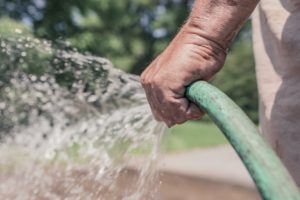 Fig trees planted in spring or summer will need lots of water during the first growing season. Their large palmate leaves wilt visibly when the soil runs dry. Hot and breezy days necessitate daily watering at first, or at least every 2 days.
Fig trees planted in spring or summer will need lots of water during the first growing season. Their large palmate leaves wilt visibly when the soil runs dry. Hot and breezy days necessitate daily watering at first, or at least every 2 days.
For new plants, provide several gallons of water (5 to 10) each time to moisten the roots and the soil around them, but keep the foliage dry to lessen the likelihood of disease. You might find it helpful to build a low dam just outside the root ball. This area allows water to slowly percolate through the root system.
Check the temperature of water coming out of the hose. If the hose sits in the summer sun, the first water to emerge will be too hot for plants.
As roots grow into the bed, reduce the frequency of watering. During drought, water the entire prepared bed (from trunk to outside the drip line) with 1 1/2″ to 2″ of water per week. Once the fig tree is fully established, water only during drought or if the leaves begin to wilt. Frequent, light watering discourages deep rooting.
Eventually, figs will seek sources of water deep underground, if they exist, such as springs and seepage from streams. This is how they adapted to life in hot dry climates around the Mediterranean Sea. Fig trees can tolerate fairly dry conditions when well established. Too much or too little water could cause fruits to drop without ripening.
Fertilizing
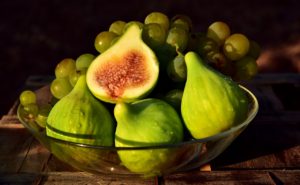
Your tree probably won’t need fertilizer until autumn if you added lots of compost at planting time. When the tree has lost its leaves in autumn, apply a small amount of low analysis fertilizer, such as 8–8–8. Some garden experts recommend not fertilizing at all in autumn.
Fertilize again or apply more compost in early spring, at bud break. Water the material into the soil.
Don’t fertilize from mid-summer through early autumn. That could push new growth when the wood should be maturing in preparation for winter. Certainly, don’t overfertilize; too much nitrogen could cause the fruits to drop prematurely.
Pruning Fig Trees
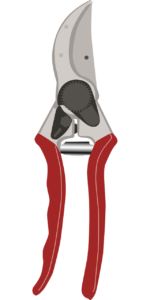 After planting, prune off any broken branches. Cut close to the stem, but not flush with it. When pruning trees and shrubs, leave the branch collar cells (a slightly raised ridge of bark) on the plant.
After planting, prune off any broken branches. Cut close to the stem, but not flush with it. When pruning trees and shrubs, leave the branch collar cells (a slightly raised ridge of bark) on the plant.
Remove stems that cross back into the center of the tree. If you can imagine a bird’s eye view, looking down from the top of the tree, all the main branches should radiate out from the central axis.
If the tree has a crowded structure, remove all but one of the branches that emerge from near the same point on the trunk. Adequate spacing between the branches assures good air circulation to lessen the incidence of insect and disease damage. It also allows adequate light to produce fruit-bearing stems.
After the initial pruning, if it’s necessary at all, there’s little you’ll have to do. If the canopy grows so densely that fruit production is diminished, it will need to be opened up. But never “top” the tree or “head back” the branches. This will result in a mass of undersized twigs that will require even more rehabilitative pruning later.
“Drop-crotch pruning” is the recommended technique to restrain dimensions. A long branch is cut down to a strong outfacing stem, one that grows outward from the center of the tree.
With expert pruning, most varieties can be kept under 8′. Better yet, look for varieties that won’t outgrow the location any time soon. Severe pruning might necessitate painting the bark to prevent sun scald.
Broken, crossing, or diseased branches can be cut at any time, but reserve major pruning for late winter.
Foliage
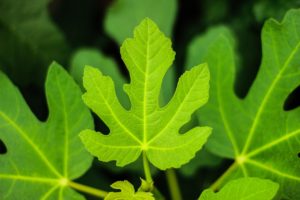
Figs are members of the mulberry family, Moraceae. They have deeply lobed palmate leaves arranged alternately along the stem. Tiny hairs, or pubescence, covering the leaves help protect them from excessive drying in hot climates. The hairs create a boundary layer next to the leaf, mitigating moisture loss.
Be careful when handling the plant, because the hairs and the milky sap, in sunlight, can cause skin irritations.
Fruits Of Fig Trees
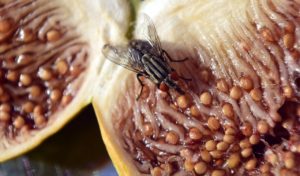
Everyone likes figs.
The fruit is the infructescence of the tree, a synconium containing 1-seeded fruits or druplets (photo, right). The fruit is actually a portion of the stem that expands into a sac with internal flowers. Got all that?
The common figs sold today contain only female flowers, and do not require pollination. Therefore, you don’t need 2 trees for cross-pollination. Almost all trees are vegetatively propagated from cuttings.
After the cuttings root, trees will bear fruit 3 to 5 years later under good growing conditions. At times, new plants can emerge from stolons growing close to the soil surface. Large numbers of them might need to be controlled or you could end up with a dense thicket of fig trees.
Pick the fruits when they’re ripe; they do not continue to ripen after harvest. A fruit that is approaching maturity will begin to droop on the stem. It’s time to pick if the fruit is soft when gently squeezed.
That Little Fig Wasp
In their native lands, where the other 800 or so species of figs grow, fig wasps pollinate the flowers. Each fig species growing in its native environment has its own wasp species that pollinates the internal flowers. This is called mutualism, where a plant species and an insect evolved together in a mutually advantageous relationship.
For some types of edible figs, the tiny Blastophaga psenes wasp enters through a small pore—the ostiole—visible at the end of the fruit. The fertile female wasp enters the fig, where she lays her eggs. The young develop there, and eventually the male wasps dig tiny tunnels for the emerging females, which are fertilized on their way out. Wingless males remain inside the fruit, “digested” by a substance called ficin.
One myth states that the crunch you feel when eating a fig is that wasp being crushed. But this is not true. The crunch is from the seeds. These “seeds” are the actual fruits (achenes) of the plant. Besides, almost all of our gardens do not support those little wasps, and common figs don’t need them to grow fruits.
In California’s San Joaquin Valley, you might see fig trees growing in huge orchards with paper bags hanging from their branches. These bags contain a few wasp-carrying fruits from caprifigs to pollinate the Calimyrna figs. Moving pollen from one type of fig to another for the purpose of setting fruit is called caprification. Pollen-producing male caprifigs grow elsewhere, since over-pollinating the figs results in bursting fruits.
All figs growing in our home gardens, however, are the common figs, which do not require pollination.
Many websites amuse their readers with tales of crunchy wasp bodies inside the figs, but this is a myth. Where most of us grow fig trees, those little wasps don’t exist. So, how do the fruits get pollinated? Well, they don’t need to be pollinated because they’re all descendants of that original parthenocarpic ancestor.
More Than One Crop?
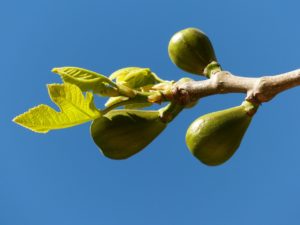 Figs set fruit once, twice, or more times per year, depending on variety and growing season. The first crop, called the breba crop, develops on last year’s wood. Although some consider this crop inferior, I wouldn’t turn it down. You can see, in the photograph, fruits start growing as the first leaves emerge.
Figs set fruit once, twice, or more times per year, depending on variety and growing season. The first crop, called the breba crop, develops on last year’s wood. Although some consider this crop inferior, I wouldn’t turn it down. You can see, in the photograph, fruits start growing as the first leaves emerge.
The main crop grows on the current season’s wood. Inland, fig trees can bear from June through September. Cool coastal areas have to wait until later in the season, until autumn, for fruits. Fig trees growing closer to tropical regions bear fruit sporadically through the year, mostly in early summer and in midwinter.
Problems
Lack of fruits or figs that drop prematurely might have been overfertilized, especially with nitrogen, or over- or under-watered. Perhaps adverse weather conditions caused this, or maybe the plant is still too young to carry fruit.
Another problem is a soil-dwelling pest called the root knot nematode. Symptoms include wilting, yellowing foliage, general lack of vigor, and less fruiting. This problem occurs mostly in areas with hot, sandy, irrigated soil. Ask your local agricultural extension agent for advice about a beneficial nematode (Steinernema feltiae) for treatment.
Infected mites feeding on fig trees spread mosaic virus, which causes mottled yellow leaves. ‘Black Mission’ is more susceptible than others, and there is no cure for this virus.
In certain regions, pocket gophers can devastate your fig trees. Trap them, after getting approval, if necessary, or use metal planting baskets designed for this purpose.
Fig beetles, in California, can be troublesome, as they ruin the crops. Netting, in a 1/4″ mesh, draped over the trees will prevent both bird and beetle damage. Flash tape might also chase the birds away.
Four Types of Fig Trees
There are four main types of fig trees:
- Caprifig: male trees provide pollen for Smyrna figs.
- Smyrna figs need pollination by fig wasps. ‘Calimyrna’ is the fig of Fig Newton fame.
- San Pedro produces 2 crops: the first breba crop doesn’t need pollination, but the second, the Smyrna type, does.
- Common figs: readily available varieties for home consumption.
Varieties of Fig Trees
Cultivars with superior quality fruit, known for sweetness and rich flavor, include:
- ‘Alma’: light brown outside/amber inside. Late, honey flavor.
- ‘Black Mission’: black/pink. 10′ to 30′ tall, zones 8 to 11.
- ‘Brown Turkey’: brownish yellow/light red. Classic southern fig, very sweet. 25′, zones 7 to 9.
- ‘Calimyrna’: California + Smyrna. Needs pollination (see “Fruits” section, above). ‘Kassaba’ is another ‘Smyrna’ type needing pollination.
- ‘Celeste’: 7-10′ tall, brownish purple/light red. Mid-season, classic southern fig. Sweet, but can drop fruits in hot weather. Zones 6-8.
- ‘Chicago Hardy’: 15′ to 30′ tall and wide, late summer to fall harvest, zones 5 to 10.
- ‘Conadria’: yellow-green/light red. Good for drying.
- ‘Green Ischia’: green/red. Tastes like jam, very sweet.
- ‘Italian Black’: black/red. Mid-season, preserves.
- ‘Kadota’: yellow/amber. Well adapted to California. “Superb” flavor.
- ‘Lattarula’ (Italian Honey, ‘Peter’s Honey’ Fig): yellow. Zones 8 (?) to 10, grows well in pots. 15′ to 30′ tall and wide.
- ‘LSU Purple’: purple/light yellow. Mid-season, mildly sweet.
- ‘Marseilles’: greenish yellow/yellow. Mid-season, mild flavor. Thomas Jefferson introduction.
- ‘O’Rourke’: light red/red. Very early and sweet.
- ‘Papa John’: purple/red. Mid-season, rich flavor, preserves.
- ‘Sierra’: smooth interior. Fresh or dried.
- ‘Tena’: greenish yellow/light red. Likes hot, dry weather.
- ‘Violette de Bordeaux’: purplish black/light red. Sweet, rich. Mid-season, early fall, zones 7 to 10. 6′ to 10′ tall, 6′ wide. (***Update***: This is the first fig tree I planted in my new garden in northern North Carolina. After a sudden and extremely cold event on Christmas eve, 2022, the plant leafed out from the base very late the next spring. 4/14/2024)
Enjoy your summer. Maybe this is the year to plant a few fig trees! They’ll cast wonderfully cool shade over that hot patio. But plant it far enough from the patio so the ripe fruits that you missed won’t make a sticky mess on the furniture.
Headings
Page 1: Delectable, Edible Figs, Papa’s Fig Trees, Origins Of the Fig Tree (The Fig Moves To The New World, Worldwide Production, Figs as Houseplants, Inside the Box), and If It’s Too Cold (A Nod To Behnke’s)
Page 2: How To Plant and Grow Fig Trees, Hardiness, Sun, Soil Preparation For Fig Trees, Time To Plant (Mulch), Watering Fig Trees, Fertilizing, Pruning Fig Trees, Foliage, Fruits Of Fig Trees, That Little Fig Wasp, Problems, Types of Fig Trees, and Varieties of Fig Trees
